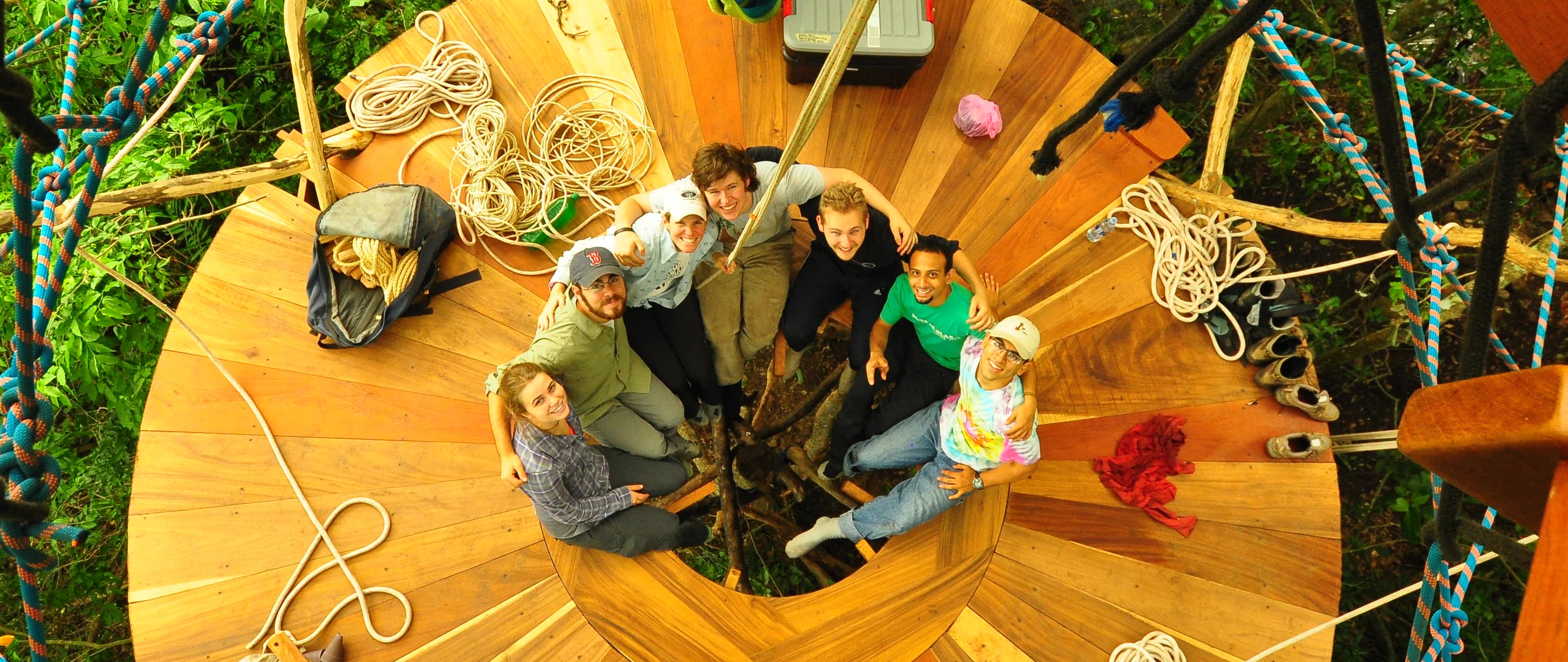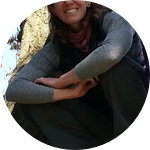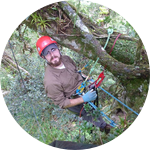About This Project
The tropical montane cloud forest provides important ecosystem services but is vulnerable to climate change. Within this ecosystem, epiphytes (non-parasitic plants that live on other plants) provide many resources but are vulnerable to drought. Changes in this community will likely affect the entire ecosystem. We will install cable-traverses & time-lapse videos to begin the first long-term monitoring program of this fascinating treetop community.Ask the Scientists
Join The DiscussionWhat is the context of this research?
The long-term monitoring of forests worldwide has become a valuable tool enabling the documentation of changes in patterns of diversity and survival as climate and land use change.
The tropical montane cloud forest may be one of the first ecosystems to experience drastic changes in species composition.
Within this ecosystem, the canopy community will likely be the first to experience changes in climate given the partial or complete dissociation between the epiphyte community and resources in the soil.
Despite the importance of this community to local and regional hydrology and the potential vulnerability of this community to changes in climate, to our knowledge there are no long-term research programs located in the canopy.
What is the significance of this project?
Epiphytes are important because they provide habitat for animals and capture cloud water that provides important nourishment for the forest, especially in the dry season.
To understand and conserve this habitat it will be necessary to create a long-term monitoring program to determine the survival of different components of the canopy community.
We propose to install cable traverses in five tree crowns in the cloud forest so that epiphytes can be repeatedly monitored without damaging the plants.
This work will be completed in collaboration with local Canopy Tour guides who have fantastic climbing abilities but are not often afforded opportunities to learn about the ecosystem they guide tourists through.
What are the goals of the project?
1) Install semi-permanent cable traverses that will allow repeated measurements of epiphyte communities over the long-term without causing any disturbance to the plants.
2) Install time-lapse video cameras that will photograph fixed locations in the canopy every hour throughout the year to aid in the observation of important processes such as leaf production, leaf shedding, flowering and survival in the dry season.
Budget
We are asking for funding to purchase and install cable traverses in five tree canopies in the Tropical Montane Cloud Forest of Monteverde Costa Rica. The cable for each tree will cost $500 (two cable traverses per tree) and the installation will cost $350 per tree. We are also asking for funds to purchase and install time-lapse video cameras in each of the trees. These cameras cost $150 each and we are asking for five, one per tree.
Meet the Team
Team Bio
I got my first scar at the age of five when I fell out of a cherry tree. I climb trees now for my research but I use ropes and a harness. I am a plant ecophysiologist, which means that I study how plant function is influenced by environmental conditions. I am particularly interested in understanding how plants handle stressful conditions such as drought.In 2012, I started a research program on the ecophysiology of epiphytes in the tropical montane cloud forest of Monteverde, Costa Rica. Epiphytes are a fascinating community of plants to study. We don’t know too much about them, they are of critical importance to ecosystem function and they are likely very vulnerable to projected changes in climate.
In addition to my research program, I have recently completed the construction of two aerial platforms near our study sites that will be the location of a tropical tree climbing school.
When I am not climbing trees for my research, you can find me, CLIMBING TREES!
Sybil G. Gotsch
I got my first scar at the age of five when I fell out of a cherry tree. I look at this permanent mark everyday and remember my times day-dreaming in my make-believe tree house in my parents back yard.
Now I am a professional biologist, a plant ecophysiologist, which means that I study how plant function is driven by environmental conditions. I am particularly interested in understanding how plants handle stressful situations, especially those that may be imposed by changes in climate. I have been working in this field, plant ecophysiology, for 16 years and have had the great fortune of conducting research in tropical dry forests, seasonal wet tropical forests and starting in 2009, in the tropical montane cloud forests (TMCF) of Mexico, Hawaii and Costa Rica.
In 2012, I joined the faculty at Franklin and Marshall College and I have started a research program on the ecophysiology of epiphytes in the TMCF of Monteverde Costa Rica. Epiphytes are a fascinating community of plants to study. We don’t know too much about them, they are of critical importance to ecosystem functioning in the TMCF and they are likely very vulnerable to projected changes in climate.
Last summer my students and I were able to, for the first time, quantify whole-plant transpiration in the canopy epiphyte community and determine the extent to which epiphytes can reabsorb cloud water directly through their leaves as a strategy to improve water status. In addition, we discovered that epiphytes exhibit a variety of ecological strategies but that all species have high water storage capacity.
In addition to my research program, I have recently begun the construction of two aerial platforms near our study sites that will be the location of a tropical tree climbing school.
Andrew Glunk
When I arrived at Franklin and Marshall College, I never envisioned myself having the opportunity to join a lab that involved repelling down 200 year old fig trees, taking lunch breaks 100 ft above the forest floor, or branch walking to reach the perfect plant sample. I first learned of Dr. Gotsch's research my sophomore year of college and immediately became interested. It combined working outdoors with meaningful biological research. Since joining the lab I have had the opportunity to spend two summers in Costa Rica conducting research. I have specialized in studying physiological traits of canopy plants to better understand community adaptations and drought resistance.
Ken Davidson
As a child I spent as much time outdoors as I could. I was fascinated by the natural world and how it worked. Ecology was not a science to me, but a part of appreciating nature. Now as a young adult I have taking this passion with me to my education. From understanding forest diversity in New England, to epiphyte physiology in Monteverde Costa Rica, I am always curious about how and why plants do what they do.
Ignacio Picado Fallas
I grew up in an environment where water resources were never lacking-we breathed them in, life existed in excess and on everything you placed your sight on; you were not the center of life as in other places, but played a role insignificant and almost unnecessary. Monteverde taught me to appreciate and preserve nature, and make the life of other people safe and beneficiary.
Additional Information
This is our field crew from the summer of 2014 at the end of tree climbing training. Students hone their climbing skills in this drier forest and we sleep on this beautiful platform which is a joint project between Lynx Guimond and Sybil Gotsch. All the plants in this picture are epiphytes. There is a layer of soil that collects on branches and the epiphytes colonize that soil. The epiphytes collect rainwater and airborne nutrients and supply it to the forest.
All the plants in this picture are epiphytes. There is a layer of soil that collects on branches and the epiphytes colonize that soil. The epiphytes collect rainwater and airborne nutrients and supply it to the forest.
This small platform was built by friend and artist/carpenter/climber, Lynx Guimond and installed by Sybil and Lynx. We use this platform for tree climbing training for my students. My students learn to climb in this drier forest 10 minutes down the hill from the cloud forest (notice the lack of epiphytes on the branches) so they acquire the skills to climb effectively in our wetter study sites.
 This is a treetop view of "El Valle", our wettest study site. Even in death there is life! There are dead branches in the foreground that are covered with epiphytes. Some of these epiphytes are in the blueberry family. There are blueberry-like bushes 100 ft. off the ground!
This is a treetop view of "El Valle", our wettest study site. Even in death there is life! There are dead branches in the foreground that are covered with epiphytes. Some of these epiphytes are in the blueberry family. There are blueberry-like bushes 100 ft. off the ground!
Here is one of my younger students, Ignacio Picado Fallas, who is a rising sophomore at Franklin and Marshall College and a native of Monteverde Costa Rica. Ignacio just installed a time-lapse camera and is reaching out to collect a sample.

This is Sybil checking on a transpiration station. Currently we are working to understand how much water is stored in and flows through these plants. Each roll of cable goes out to a particular plant and there is a sensor that is attached to the stem to detect the rate of movement of water up or down the stem.

This is Erica Hample who joined the team this summer from Hampshire College. Erica is checking on a weather station. This was her first lateral climb. All the plants in the foreground are epiphytes living on this huge 120 ft strangler fig tree.

This is the large platform that we use as a base of operations for tree climbing training. Students sleep on the beautiful wooden base and the professor sleeps in her tree hammock in the penthouse :)

Project Backers
- 94Backers
- 105%Funded
- $5,264Total Donations
- $56.00Average Donation




